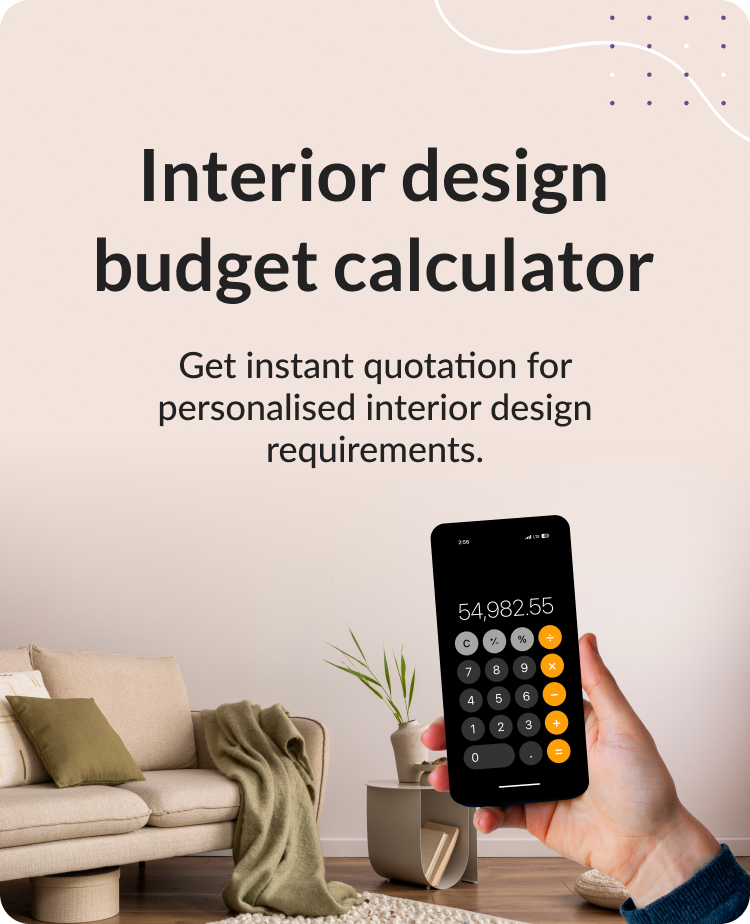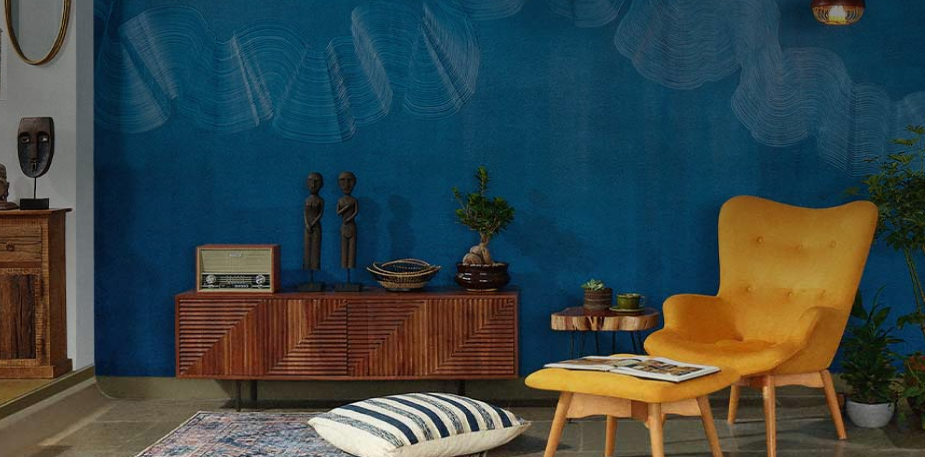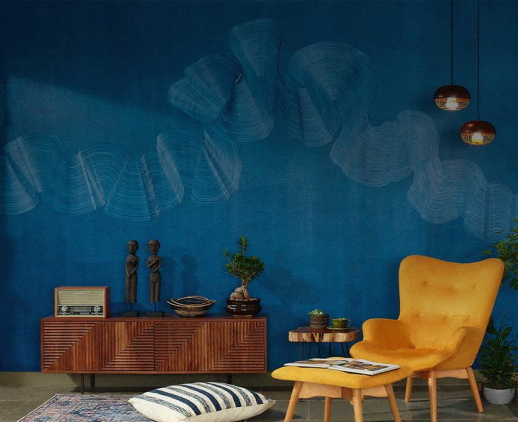Get your home interior design budget estimate
Bedroom Design

What is bedroom design?
Bedroom design refers to the art and science of creating a functional, aesthetically pleasing space where people can rest and rejuvenate. It involves strategizing the layout of furniture, choosing colour schemes, selecting bedding and curtains, arranging lighting, and more. Each element is chosen carefully to create a harmonious environment that reflects the personality and lifestyle of the person using the room.
Here is a room design checklist with the key components of a bedroom design, that include:
1. Layout:
This involves deciding where to place the bed, wardrobe, desk, seating, etc. Good layout and bed room planning ensures easy movement and functionality in the room.

2. Colour Scheme:
The colours used in a bedroom can greatly affect mood. Soft, neutral tones are often used for a relaxing atmosphere, while brighter colours can energise the space.

3. Furniture:
The bed is typically the centrepiece of any bedroom, but other furniture like wardrobes, dressers, nightstands, and chairs also play important roles. Furniture should be chosen not just for style, but also for comfort and utility.

4. Lighting:
Proper lighting design includes a mix of ambient, task, and accent lighting. Ambient lighting provides overall illumination, task lighting is for specific tasks like reading, and accent lighting highlights certain elements in the room. Latest bedroom design ideas have a high focus on aesthetic lighting.

5. Décor:
This includes accessories like artwork, rugs, pillows, and plants that add personality to the room. Small bedroom furnishing ideas can also have a huge overall impact.

6. Textiles:
Bedding, curtains, and rugs add texture and warmth to a bedroom. They also play a role in noise reduction and light control.

What are the different types of bedrooms?
Bedrooms can be categorised in various ways, including by their size, function, style, and the number of beds they contain. Here are some common types of bedrooms:
1. Master Bedroom Design:
Master Bedroom is typically the largest bedroom in a home, often featuring an en-suite bathroom and ample closet space.
2. Guest Bedroom:
A guest room design accommodates visitors. It usually has a comfortable bed, storage space for belongings, and sometimes a private bathroom.
3. Children's Bedroom:
Childrens bedrooms are designed for kids, often featuring playful decor, durable furniture, and safety features such as rounded corners and secure windows.
4. Teenage Bedroom:
A bedroom for teenagers often reflects their developing personal style. It might include a study area, more mature decor, and space for hobbies or interests.
5. Nursery:
A nursery is a room designed for a baby. It typically includes a crib, changing table, and rocking chair, plus storage for baby essentials.

6. Single Bedroom:
This is a small bedroom designed for one person. It typically contains a single bed size.
7. Double Bedroom:
This room is larger than a single bedroom and contains a double bed meant to accommodate two people. This can also be used for a master bedroom design.
8. Twin Bedroom:
A twin bedroom has two single beds, making it ideal for siblings sharing a room or for guest room designs.
In terms of style, bedrooms can be traditional, modern, contemporary, rustic, minimalist, or themed (such as a beach theme or a sports theme), among others. The design and decor of the bedroom typically reflect the personal taste and lifestyle of the occupant(s). For single bedrooms, one can refer to small bedroom furnishing ideas to bring out their design tastes.
Types of Bedroom Design
Bedroom design can vary greatly depending on personal taste, needs, and the overall style of a home. Here are some popular types:
1. Modern:
Modern bedroom designs often feature latest design idea trends like clean lines, simple colour palettes, and minimalist decor. Furniture is often made of materials like steel, glass, and metal.
2. Contemporary:
Although sometimes used interchangeably with "modern," contemporary design actually refers to styles that are current and evolving. It often incorporates elements from various styles and eras.
3. Traditional:
Traditional bedrooms are characterised by classic furniture, symmetrical arrangements, and a cosy, comfortable ambience.
4. Rustic:
Rustic design focuses on raw, natural materials. Think wooden beams, warm colours, and elements that evoke a sense of the great outdoors.
5. Industrial:
This style draws inspiration from urban lofts and old factories. It often incorporates exposed brick, metal, and weathered wood.

6. Scandinavian:
Known for simplicity and functionality, Scandinavian design features white walls, wooden floors, modern furniture, and a focus on light.
7. Bohemian (Boho):
Boho bedrooms often feature eclectic decor, vibrant colours, a mix of patterns, and a laid-back, global vibe.
8. Farmhouse:
Farmhouse style is warm and welcoming, featuring vintage furniture, shiplap walls, and rustic accents.
9. Minimalist:
Minimalist design is all about simplicity. It often features a restricted colour palette, functional furniture, and very limited decor.
10. Coastal/Beach:
This style is characterised by a light and breezy atmosphere, with colour schemes inspired by the beach, and decor that features nautical or marine items.

Your bedroom should be a reflection of your personal style and a place where you feel completely at ease. Whether you prefer a classic traditional look or a sleek modern and latest bedroom design idea, the most important thing is that it suits you and your lifestyle.
How to design a bedroom?
Designing a bedroom can be a fun and rewarding experience. Your interior design service provider can help you with the details about the bedroom interior design with price. Here is an overview of a bedroom design checklist to guide you through the process:
1. Understand Your Needs:
Before you begin, consider who the room is for. A master bedroom design may require different elements than a guest room design or a child's room.
2. Identify Your Style:
Look for inspiration online or in magazines to identify your personal style. Do you prefer modern, traditional, rustic, boho, or some latest bedroom design style?
3. Plan Your Layout:
Measure your room and plan where each piece of furniture will go. Consider the location of doors and windows, and remember to allow for walkways. Even if your space is compact, there are plenty of small bedroom ideas to maximise it.

4. Choose a Colour Scheme:
Colour can greatly influence the mood of a room. Light colours can make a small room feel larger and brighter, while dark colours can add drama and cosiness.

5. Select Your Furniture:
Start with the bed, as it's usually the largest piece and the focal point of the room. Then add items like nightstands, a dresser, and a chair. Remember to keep your layout in mind.
6. Consider Storage:
Look for ways to add storage. This could be under-bed storage, built-in shelves, a large dresser, or even a wardrobe.

7. Add Lighting:
Layer your lighting with a combination of ambient, task, and accent lights. Don't forget bedside lamps for reading.
8. Choose Your Bedding:
This is a chance to bring in texture and pattern. You might choose crisp white linens, a plush comforter, or colourful throw pillows.
9. Decorate:
Add personal touches like artwork, photos, rugs, and curtains. These should complement your colour scheme and reflect your personal style.
10. Review and Revise:
Live with your design for a few days. You might find that you need to tweak certain elements or that something is missing.
Designing a bedroom is a personal process. The most important thing is to create a space that feels comfortable and relaxing to you.
Colour combinations for bedroom design
Choosing the right bedroom wall colour combinations can significantly influence the room's mood and overall aesthetic. Here are some popular palettes and trending two colour combinations for bedroom walls to give you some guidance on bedroom design ideas:
1. Monochromatic:
A monochromatic colour scheme can create a peaceful and inviting atmosphere in the bedroom. This could involve combining various shades of one colour, like grey or beige. This could work great for small bedroom ideas to make the space appear larger.

2. Bold and Bright:
Bold, bright colours can be a great bedroom wall colour combinations. Think vibrant blues, pinks, or even a rich emerald green paired with white or other neutrals in areas like the bedroom floor tiles design to balance the look. This choice goes well with two colour combinations for bedroom walls that include one bright and one subtle colour.

3. Pastel Colours:
Pastel colour schemes are a stylish choice in latest bedroom designs that can bring cohesion to a space. Bedroom finishes in pastels like mint green, baby blue, or blush pink can make a room feel calm, light, and airy.

4. White and Blue:
A classic two colour combination for bedroom walls, white bedding and grey walls with black and blue accessories creates a visually pleasing contrast and a calming environment.

5. Earth Tones:
Earth tones like browns, greens, and creams can make a bedroom feel warm and soothing. These colours are inspired by nature and can be great for creating a serene, organic feel. Earth tones are very popular in bedroom floor tiles designs and small bedroom ideas. An example of a two colour combination for bedroom walls is walnut brown with ivory.

6. Soft Greys and Yellows:
A two colour combination for bedroom walls, soft greys and yellows for both large and small spaces can make a room feel cosy yet cheerful.
The best bedroom wall colour combination depends on your personal taste and the mood you want to create in your space.
Furniture design for bedroom
I. Layout guide
Designing a layout involves careful bed room planning and consideration. Here's a step-by-step guide to help you create a functional and stylish layout that aligns with latest bedroom designs:
Step 1: Measure Your Room
Before you start, measure your room accurately. Include the dimensions of all walls, windows, doors, and any other architectural features. This will help you understand how much space you have to work with for your bedroom and wardrobe design. Depending on the size, you can go with small bedroom furnishing ideas or spacious bedroom ideas. Your bed room floor tiles design will also depend on the size.
Step 2: Identify the Focal Point of your Bed room Planning
The focal point is the first thing you see when you enter the room. It could be a large window, an architectural feature, or a piece of furniture like your bed. Your bed should ideally face this focal point.

Step 3: Consider the Size and Shape of Your Room
Take into account the size and shape of your room. If it's long and narrow, placing the bed at the far end can add depth. For square rooms, positioning the bed on the wall opposite the door can create balance. The bedroom and wardrobe design for larger spaces might significantly differ from furniture for small bedrooms.
Step 4: Plan for Storage
Decide where you'll place wardrobes, dressers, or shelving units. Ensure there's enough space for these pieces in relation to your bed and other furniture.

Step 5: Think About Movement in your Bed room Planning
Consider how you move through the space. There should be enough room to walk around comfortably, especially between the bed and the bathroom or the bed and the door. All kinds of beds require different space proportions.
Step 6: Decide on Furniture Placement for your bed room planning
Begin with your bed since it's the largest piece of furniture. Consider whether it will be a king size bed or a smaller one. Then, think about where to place your other furniture – bedside tables, a desk, a chair, etc. Remember to leave enough space between items for easy movement.

Step 7: Experiment with Different Arrangements for Bed room Planning
Don't be afraid to try different setups until you find what works best for your bed room planning. You might need to move things around a few times before you're satisfied. This might be an easier task in case of furniture for small bedrooms.

Step 8: Add Personal Touches
Once you're happy with the bed room planning layout, add personal touches. This could be artwork, photos, cushions, or a rug. These items will make the room feel like your own. You can also employ innovative bed room floor tiles designs. Using creative small bedroom furnishing ideas, you can transform a modest space into a cosy, welcoming nook.
The goal is to create a space that's both functional and pleasing to the eye. Your bedroom should be a relaxing haven where you can unwind and recharge. If your bedroom is relatively compact, the above points also work well with small bedroom furnishing ideas.
II. Material guide
When it comes to bedroom and wardrobe design, the choice of materials can significantly affect both the look and functionality of the space. Here's a guide to some materials often used in latest bedroom design:
1. Metal:
This material is versatile and durable, making it ideal for various forms such as rods, railings, support structures, sheets, and pipes. It's well-suited for specific interior design styles.
2. Faux Marble:
Faux marble is an affordable alternative to real marble and is often used for tabletops due to its luxurious appearance. It allows you to achieve the high-end look of marble in bedroom finishes without the associated cost and maintenance.
3. Timber:
Timber and other natural materials are commonly used in rustic furniture designs. They add a sense of warmth and cosiness to the room, making it feel more inviting and comfortable. Timber furniture can also be matched well with wooden bed room floor tiles designs.

4. Cotton and Linen:
These materials are popular choices for upholstery because of their comfort and breathability. They're also incredibly versatile and can complement various design styles.
5. Hide:
Hide or leather is another material often found in furniture design. It exudes luxury and sophistication and ages well, developing character over time.
6. Colour and Fabric Selection:
The colour and fabric of your furniture can dramatically influence the mood and style of your room. Make sure to consider the overall design theme and colour scheme of your bedroom when making your selection.

When selecting materials for your bedroom furniture, it's crucial to consider both their aesthetic appeal and practicality. You can also use POP design for bedrooms to amp up the look of your furniture. You may find it helpful to list potential materials and weigh their pros and cons to ensure you're satisfied with the final result.
Remember, the best material for your bedroom furniture will depend on your personal style, the room's overall design, and the intended use of the furniture. Don't be afraid to experiment until you find what works best for you.
Bed design for bedroom
I. What are the different types of beds?
All kinds of beds come in numerous types and styles, each offering unique features and benefits. Here are some common varieties of beds:
1. Platform Bed:
This bed has a flat base that supports the mattress without the need for a box spring. It's usually lower to the ground and offers a clean, modern look. It is a preferred choice for a king size bed.

2. Panel Bed:
Characterised by a tall, decorative headboard and a footboard, this bed requires a box spring to support the mattress. This style is suitable for a king or queen size bed.
3. Sleigh Bed:
This bed has a curved headboard and footboard that resemble a sleigh, hence the name. It's a traditional and elegant style.
4. Canopy Bed:
Known for its tall, dramatic posts connected by a canopy frame, this bed can be draped with fabric for a luxurious feel. A king size bed with a canopy is an ultimate example of grandeur.

5. Murphy Bed:
Also known as a wall bed, this is a space-saving option where the bed folds into the wall when not in use. It generally employs a queen size bed.
6. Bunk Bed:
This type consists of two or more beds stacked on top of each other, making it ideal for children's rooms or places where space is limited. It is the most commonly used varieties of beds in hostels or dorms.

7. Loft Bed:
Similar to a bunk bed, but instead of a lower bed, there's space for things like a desk or storage.
8. Trundle Bed:
This bed has a second bed underneath that can be pulled out when needed, perfect for guest room designs.
9. Daybed:
A multi-purpose piece, it can serve as a sofa during the day and a bed at night. Some also have a trundle for extra sleeping space. A queen size bed is an apt size for these kinds of beds.
10. Futon:
A futon is a padded mat that can be folded up for storage. In Western countries, it often refers to a sofa that can be unfolded into a bed.

11. Adjustable Bed:
These beds can be adjusted (either manually or electronically) to different positions for comfort, often used for medical reasons or to reduce snoring.
12. Divan Bed:
It's a box spring with a mattress on top and often includes built-in storage drawers. This style is suitable for a king size bed or a queen size bed.
All kinds of beds offer different benefits, and the best choice depends on your personal needs, taste, and the space available in your room.
II. Dimensions guide
1. Dimensions:
Queen size beds are typically 60 inches wide and 80 inches long (152 cm x 203 cm). This is a comfortable size for two people with enough room to move around.
Full double bed sizes, commonly used in guest room designs and medium-sized bedrooms, are 75” (191 cm) long and 54” (137 cm) wide.
King size beds measure 72x78 inches and are suitable for master bedroom designs that are at least 12 feet wide.
2. Headboard:
The headboard width can match the width of the bed and can be anywhere from 20-28 inches tall depending on your preference and the style of the bed. A taller headboard can become a statement piece, while a shorter one is more subtle. King size beds or larger beds may have headboards that become a part of the wall.

3. Footboard:
Footboards aren't necessary but can add a traditional touch to your bed. If you opt for one, it should match the width of the bed and be shorter than the headboard - usually around 15-20 inches tall.
4. Frame Height:
The height of the bed frame can vary based on your comfort and design style. The average height tends to be around 25 inches (including the mattress), but it can range from 18-36 inches.
5. Clearance:
To ensure you can move comfortably around the bed, leave a clearance of at least 30 inches on each side and at the foot of the bed. Furniture for master bedroom designs can have larger clearances.
These are just guidelines. The actual design and dimensions can be adjusted based on your specific needs, the size of your bedroom, and your personal style. Always measure your space before finalising any furniture dimensions.
III. Tips to Choose your Bed:
1. Size-up your room
For starters, measure your bedroom and have a furniture layout in place before you start browsing for options. Pen down the essentials you would need – bedside tables, chest of drawers, wardrobe, dressers, etc before deciding on what bed you want.
2. Consider the tallest person
The bed should be at least four to six inches longer than the tallest person in your house. This should give you a starting point for shortlisting the kind of bed you need.
3. Visit a few stores
You can’t really get a good idea by looking at pictures of furniture on a screen. Exploring stores allows you to look at different styles, shapes, sizes, designs and finishes to suit your needs.
4. Choose a style
Next, think about what features you want in your bed. Consider storage as an important aspect – you can stash everything you don’t use regularly here. If you enjoy bed time reading, opt for a cushioned headboard so you can lean on it comfortably. If your room is large, hang a canopy or opt for a four-poster bed with sheer curtains.
5. Choose the material
Wooden beds are popular as they are durable and can be found in several finishes – veneer, laminate and even paint. Wrought iron beds look sleeker and are fairly easy on the pocket.
6. Buy a new mattress
If you are opting for a foam mattress, it would be ideal that your bed have wooden slats. Buy your mattress and bed at the same time so they wear out together.
7. Read before you book
With so many options available on the internet, it becomes imperative to read reviews before buying. The best bed for you may not be the most expensive one. The cheapest bed may not be the most comfortable. It always helps to know other’s experiences on all kinds of beds before making the purchase.
Wardrobe Design for bedroom
Tips to select a wardrobe design for bedrooms:
Analyse the Space you Live in
While the bedroom woodwork designs of your dreams may lead you somewhere, the space available in your home may not be conducive to your dreams. It is essential to realistically map out the floor area you can play with in your bedroom, and to use it as a starting point to build your modern bedroom cupboard designs thereon.

Consider the Environmental Factors
In a country like India, dust is a big problem every house is prone to and modern bedroom cupboard designs need to be mindful of it. Options such as open, free-standing shelves are wonderful modern bedroom cupboard designs but the hustle of keeping them clean can turn your design dream into a nightmare. The same goes for walk-in closets: unless they’re fitted with dust-proof doors with no gaps, you’ll create a space where dirt will very likely accumulate regularly, right next to where you sleep.

If the walls around your wardrobes are prone to mould or leakage, you might want to keep an eye on them by fixing or repairing them regularly, as the mould can seep into your closet’s wood—leaving a musty odour initially and damaging your clothes over time.
Work with What you Have
This rule holds true especially for rental apartments where your bedroom and wardrobe designs are probably already fitted. It may not be what you initially hoped for, but you could work around it, to create a closet that is functional as well as truer to your style. If you don’t like the wardrobe visually, consider polishing the wood in a stain of your choice or maybe even painting it to add a pop of colour to the room.
To tweak the bedroom design a bit more, add the storage racks, drawer inserts or acrylic trays and boxes to maximise space inside your wardrobe design for bedroom and create a closet area closer to your needs.

It is crucial to use space saving furniture, especially in wardrobes, to avoid blocking large chunks of space. When choosing a wardrobe design for bedrooms, it's important to consider both the dimensions and the materials that will best suit your space and storage needs.
Dimensions
Standard Wardrobe dimensions:
A wardrobe design for bedroom standard size is typically a width of 6 feet and a depth of 2 feet, which provides ample storage for garments and blankets.
Per Person Space:
If the wardrobe is being shared, it's recommended to have at least 1800mm in length per person as standard wardrobe dimensions. For walk-in wardrobe design for bedrooms, this increases to 2400mm per person.
Height:
Bedroom and wardrobe design for bedroom need to align in many technical areas. The height of your wardrobe will depend on your ceiling height and personal preference. However, a common height among standard wardrobe dimensions is around 7 feet.
Materials
Wood:
This is the most traditional material for wardrobe design for bedrooms because of its durability and versatility. Types of wood used can range from oak, maple, pine, to engineered wood like MDF or particle board.

Laminates:
These are often used for their variety of colours and designs, resistance to wear and tear, and affordability. High-pressure laminates are especially popular in modern bedroom cupboard designs for their durability.

Mirror:
Mirror panels can be incorporated into the wardrobe design to make the room appear more spacious and provide a full-length mirror for dressing.

Metal:
Metal wardrobes can offer a sleek, modern look and are known for their durability and easy maintenance.

Side Table Design for bedroom
Designing a bedside table involves considering both dimensions and materials to ensure it complements your bed and other furniture. Here are some general guidelines:
Dimensions
Height:
The height of your bedside table should be roughly equal to the height of your mattress top. This usually falls somewhere between 23-28 inches (58-71 cm).
Width:
The width can vary, but a good standard to follow is between 18-24 inches (46-61 cm). This provides enough space for a lamp, alarm clock, or other items, but also ensures it doesn't take up too much floor space.
Depth:
The depth (front to back) of the bedside table is often less than the width, around 15-18 inches (38-46 cm) is common. This helps prevent the table from protruding too far into the room.

Materials for different types of bedside tables
Wood:
Wood is a classic choice for a bedside cabinet with drawers due to its durability and versatility. Types of wood used can range from oak, maple, pine to engineered wood like MDF or particle board.

Metal:
Metal side tables can offer a more modern or industrial look. They're durable and easy to clean, and can be used as bedside cabinet with drawers.

Glass:
Glass can provide a sleek, contemporary look. It can make a small space feel larger because of its transparency, but it requires regular cleaning to maintain its shine.
Composite/Engineered Wood:
These materials for bedside cabinet with drawers are affordable and can come in a variety of finishes to match with varieties of beds.
Lights for Bedroom design
I. Types of lights for bedrooms
Lighting plays a crucial role in creating the right mood and ambiance in your bedroom. Here are some types of lights you might consider:
1. Ambient Lighting:
Also known as general lighting, ambient lighting offers the primary source of light, usually emanating from a central ceiling fixture. It sets the overall tone of the room and ensures sufficient illumination.

2. Task Lighting:
Task lighting caters to specific activities such as reading or working. Examples include desk lamps or bedside lamps, which focus light on particular areas to facilitate tasks without straining your eyes.
3. Accent Lighting:
This type of lighting is used to spotlight unique features or items like artwork or architectural elements. Accent lighting brings drama and depth to the room by creating visual interest.

4. Recessed Lighting:
Installed within hollow openings in the false ceiling or walls, recessed lights are small night lamps for bedrooms that offer a streamlined, modern look. They're versatile, providing ambient, task, or accent lighting while maintaining a clean aesthetic.

5. Wall Sconces:
Mounted on the wall, wall sconces are small night lamps for bedrooms that emit soft, diffused light. They can serve dual purposes - providing both task and ambient lighting, while enhancing the room's décor.

6. Pendant Lights:
Pendant lights are suspended from the ceiling, offering a blend of task and ambient lighting. They add a touch of elegance to the bedroom, doubling as functional light sources and decorative pieces.

7. Chandeliers:
More than just a light source, a chandelier is a statement piece that dangles from the ceiling, providing ambient light and adding a luxurious touch to your bedroom.

8. Table Lamps:
These adaptable fixtures, placed on a bedside table or desk, offer focused task lighting. With a variety of bedroom lamps designs available, they can also contribute to the room's aesthetics.
9. Floor Lamps:
Standing tall, floor lamps deliver task and ambient lighting. They not only illuminate the room but also enhance its visual appeal with their stylish bedroom lamps designs.
10. LED Strip Lights:
LED strip lights are flexible, adhesive light strips that can be applied anywhere. They're excellent for accent lighting, adding a modern and creative flair around headboards, mirrors, or other features.
II. Tips to choose the right lighting for bedroom
Choosing the right lighting for your bedroom can greatly enhance its ambiance and functionality. Here are some tips to help you make the best choice:
1. Understand Your Needs:
The first step is to understand what you need the lighting for. Do you read in bed? Do you have artwork you'd like to spotlight? Or do you prefer a soft, romantic vibe? Your activities and preferences will dictate the type of lighting you need.
2. Layer Your Lighting:
A well-lit bedroom typically has a mix of ambient, task, and accent lighting. Ambient light provides general illumination, task lighting supports specific activities like reading, and accent lighting highlights architectural features or décor.

3. Consider the Size and Layout of the Room:
The size and layout of your bedroom will also influence your lighting choices. Larger rooms may require more light sources, while smaller rooms might benefit from strategic lighting to make the space feel larger.
4. Choose Adjustable Lighting:
Where possible, choose lights with dimmer switches. This allows you to adjust the brightness according to your needs and mood, providing flexibility.
5. Select the Right Bulbs:
The colour temperature of your bulbs can affect the mood of the room. Warm white bulbs create a cosy, relaxed atmosphere, while cool white bulbs are invigorating and ideal for task lighting.

6. Think About Style:
The style of your lighting fixtures should complement the overall décor of your bedroom. Whether you prefer a modern minimalist look, a glamorous chandelier, or rustic lanterns, make sure your lighting contributes to the aesthetic you want to achieve.
7. Don't Forget About Natural Light:
Natural light is the best light. Consider how much natural light your bedroom receives and plan your artificial lighting around it. For instance, you might want blackout curtains or blinds if your room gets a lot of morning sun, or you might need extra lighting if your room lacks sufficient natural light.

8. Prioritise Energy Efficiency:
LED lights are more energy-efficient and longer-lasting than traditional incandescent bulbs. They may be more expensive upfront, but they'll save you money in the long run.
The best lighting for your bedroom will depend on your personal preferences, your lifestyle, and the design of your space. Don't be afraid to experiment until you find what works best for you.
Flooring Design for Bedroom
Choosing the right bedroom floor design is crucial as it significantly impacts comfort and aesthetics. Factors like durability, maintenance, appearance, and feel should be considered. Several flooring options exist, each with their own pros and cons.
1. Wall-to-Wall Carpeting
Pros :
Soft and comfortable texture. Both non-slip and warm. An underlay for extra cushioning and sound buffering – in foam, rubber or felt padding – makes these floors much quieter and less dangerous.
Cons :
It stains easily and will collect allergens, dirt and dust, as well as moisture. Can be a problem for pest control. Not very pet friendly and will require extra care and effort if you have small children. Ruins the flooring beneath it. It is warm in all weathers, which may not be suitable for all parts of India.
2. Ceramic or Vitrified Tile
Pros :
Wide range of styles, prints, colours and finishes. A much cheaper option than stone and hardwood. Easy to install and maintain. Highly durable with a low porosity and an impervious surface.
Cons :
Tiles are highly prone to breakage during transport and installation; you will have to buy more tiles than are required for your floor space. Additionally, necessitates a good installation team. The grouting between the tiles will need regular cleaning and upkeep, which is both time consuming and high-effort. Even with frequent maintenance and care, tile has a shorter lifespan when compared to stone flooring.
3. Natural Stone
Pros :
A wide price range when it comes to grade, finish and pattern. Almost unlimited options to suit different budgets, décor styles and colour schemes for flooring. Most are relatively stain-resistant when finished and with appropriate maintenance, exceptionally durable. Given India’s tropical weather, stone, which stays cool for most parts of the year, is a great choice.
Cons :
Even when used indoors in a low traffic area like the bedroom, stone floors do need to be professionally sealed every 4-5 years to maintain their durability and look. Some stone flooring, such as marble, is easy to scratch or chip, and prone to acidic discolouration caused by food spills or harsh cleaning agents; maintenance can be tricky. If you live in a colder region, having various bedroom carpets ideas will be necessary, to prevent cold feet yet avoid tripping hazards.

4. Wood
Pros :
When well maintained and properly cared for, it’s durable and may never need to be replaced. More resilient than stone or tile flooring. Comes in natural shades to suit a variety of bedroom floor design ideas. Available at varying price levels to suit your budget. Creates a springy surface with more give than stone, that is comfortable to walk on. Stays cool in warm weather and warm in cool weather. Sustainable, and can be made from repurposed or recycled wood to increase its eco-friendliness.
Cons :
Over time, wear and tear can cause noises such as creaks and squeaks. Additionally, wood floors have no sound-absorption value or insulation. Vulnerable to moisture and extreme weather conditions, they will require extra maintenance and care to avoid warping and deterioration of the wood.
5. Terracotta
Pros :
Very resistant to scratches and other damage, and will quickly absorb liquids that are spilled upon the surface. While the addition of a carpet for bedroom floor décor, can add to your style, it isn’t needed as this natural material remains a comfortable temperature no matter the weather. Since there is a natural temperature regulation and comfortable feel to this flooring, bed ideas can be more varied, with even floor level bedding being cosy throughout the year.
Cons :
As it only comes in earth tones, you do need to be careful about your colour choices for the rest of the room, which can be slightly limiting. As mentioned in the pro section, it will quickly absorb liquids, so you do need to be careful to wipe up any potential stains.

6. Red-Oxide Or Cement
Pros :
For bedroom flooring, these materials are extremely durable and easy maintenance. Oxide floors are cool to the touch, which makes them a great choice in warmer areas and tropical climates.
Cons :
Finding experienced professionals who can create these floors to your specifications may be a little difficult. Your colour choices are limited. If the floor is improperly finished, the colour can bleed. Can be very slippery when wet and isn’t always the best fit for décor that is heavy on bedroom carpet design themes.
Vastu for Bedroom
Vastu Shastra, an ancient Indian science of architecture, offers guidance on how to design spaces in harmony with the natural forces. It guides on bedroom directions as per vastu, design elements, colours etc. Here are some tips on designing as per Vastu for bedroom:
1. Bed Position:
The bed should be placed in such a way that while sleeping, your head is towards the east or south. Avoid placing the bed directly in line with the door.
2. Mirrors:
Mirrors play an important role in Vastu. If you have a dressing table, placing it next to the bed is considered auspicious. However, avoid having a mirror that reflects the bed, as it's believed to cause unrest and conflicts.

3. Bedroom direction as per Vastu
- Vastu shastra for master bedroom: The master bedroom direction as per Vastu should ideally be positioned in the South-west corner of the house, as it is connected with good health, prosperity and longevity. In case, the house is multi-story, the best bedroom direction as per Vastu is to the southwest on the top floor. As per vastu shastra for master bedroom, it should be larger than any other room in the house.
- The north-west direction is also a good bedroom direction as per vastu and best serves as the guest bedroom or children’s bedroom.
- Bedrooms in the southeast or northeast corners should be avoided if feasible, as they aren’t good bedroom directions as per vastu.
4. Colour Scheme:
Colours also play a significant role in Vastu. Light colours are recommended for bedrooms as they are soothing and promote relaxation and healing.
5. Door and Window Placement:
The door to the bedroom should be set up in the east, north, or west. Windows should ideally be on the eastern or northern walls.
6. Avoid Clutter:
A clutter-free bedroom is essential for positive energy flow. Make sure to keep your bedroom tidy and organised.
7. Avoid Electronic Gadgets:
As per Vastu, electronic devices like TVs, computers, and mobile phones should be kept out of the bedroom as they disrupt the peaceful environment.
8. Artwork and Images:
Choose calming and cheerful images for your bedroom decor. Avoid pictures depicting violence or sorrow.

How to design a bedroom in a small space?
Designing a bedroom in a small space can be a fun and creative challenge. Here are some tips with small bedroom furnishing ideas to help you make the most of your space:
1. Choose Light Colours:
Light colours tend to make rooms appear larger. Consider painting your walls a light colour and matching it with light-coloured furniture.
2. Use Mirrors:
Mirrors can give the illusion of more space by reflecting light around the room. Consider placing a mirror on the wall or having mirrored closet doors.

3. Maximise Storage:
Look for furniture that doubles as storage, such as a bed with drawers underneath or a headboard with shelves.
4. Go Vertical:
Use the walls for storage. Install shelves or wall-mounted nightstands to free up floor space. You can refer to small bedroom furnishing ideas with innovative storage solutions that also add an aesthetic edge.
5. Choose the Right Furniture:
Choose pieces that are the right scale for your room. Too many large pieces can make the room feel cramped.
6. Minimalism is Key:
Avoid clutter. Keep only what you need and use regularly. A clean, uncluttered space always feels larger. A clean space trumps all small bedroom ideas.
7. Strategically Place Your Bed:
The placement of your bed can greatly impact the perceived space in the room. Try to place it against the longest wall or in a corner.
8. Use Multi-Functional Furniture:
A desk can double as a nightstand, or a trunk at the end of your bed can provide storage and act as a bench. Multi-purpose furniture is one of the most useful small bedroom furnishing ideas.

9. Use Wall Sconces:
Instead of table lamps, opt for wall sconces. This will free up space on your nightstand or desk.
10. Opt for a Monochrome Palette:
Using different shades of the same colour can make the room appear larger. It creates a sense of visual coherence and unity
It is crucial to focus on functionality while still maintaining style and comfort with your small bedroom furnishing ideas. With careful planning and smart design choices, you can create a bedroom that feels spacious, comfortable, and uniquely yours.
How Beautiful Homes by Asian Paints can help you design your dream bedroom?
At Beautiful Homes, we believe that your bedroom should be a sanctuary, a personal space that reflects your taste, personality and lifestyle. We are committed to transforming your dream bedroom into reality. Our team of professional designers works closely with you to understand your vision and preferences, creating a unique design that matches your aesthetic and functional needs from your bed room planning. But we don't just stop at designing. We also execute these plans meticulously, ensuring every detail aligns with the envisioned design. From choosing the right colour palette and fabrics to selecting the perfect furniture and accessories, we handle it all with precision and care. Whether you have an inclination towards small bedroom ideas with a modern minimalist look, a cosy rustic vibe, or an extravagant luxury feel, we have the expertise to bring your dream bedroom to life. Let us help you create a bedroom that is not just for sleeping, but a reflection of your dreams and aspirations.
What’s the status of your home possession?
What’s the condition of your home/space?
Will you be living in your space during the renovation ?
 Previous Question
Previous Question
Is your interior design budget over 4 lakhs?
 Previous Question
Previous Question
Book next available appointment slots with our experts!
DEC 2023
Please Select Date and Day
 Previous Question
Previous Question

Something went wrong!
We were unable to receive your details. Please try submitting them again.

Appointment Scheduled!
Thank you for giving an opportunity to Asian Paints Beautiful Homes Service! Our Customer Experience Specialist will get in touch with you soon.
Appointment Date & time
17 Oct 23, 03.00PM - 04.00PM
Thank You!
Our team will contact you for further details.

Get Started with your interior design journey with us!
Speak to our design professionals
What’s the status of your home possession?
What’s the condition of your home/space?
Will you be living in your space during the renovation?
 Previous Question
Previous Question
Is your interior design budget over 4 lakhs?
 Previous Question
Previous Question
Book next available appointment slots with our experts!
Please Select Date and Day
 Previous Question
Previous Question

Something went wrong!
We were unable to receive your details. Please try submitting them again.

Appointment Scheduled!
Thank you for giving an opportunity to Asian Paints Beautiful Homes Service! Our Customer Experience Specialist will get in touch with you soon.
Appointment Date & time







































